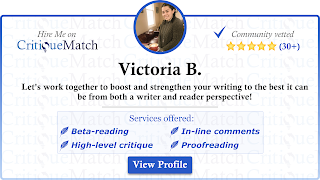By Victoria B.
The first step to learning how to use the FictionFive Contest Score Sheet is by doing something we’ve all skipped before: reading the directions! The score sheet includes five sections, for which you must give a rating and provide commentary.
Near the top of the score sheet is the key on how to rate each section. If you find that there’s some grey area between the scores, try thinking of them this way:
5 – flawless, excellent all the way around
4 – very few suggestions (i.e., suggestions on 0-25%)
3 – a handful of suggestions (i.e., suggestions on 25-50%)
2 – quite a bit of feedback needed (i.e., suggestions on 50-75%)
1 – major feedback and revisions required (i.e., suggestions on 75-100%)
Further down the score sheet you’ll see different categories with examples and a place to add your rating and feedback. Let’s go over the categories:
Category #1: Characterization – Characterization is how a character is created, construed, and described. Look for anything that really catches your attention about the main character(s), their personalities, and their interactions with the other characters.
Category #2: Pacing – Pacing is how slow or fast things are moving along in the scene and story. Ask yourself how quickly you were able to figure out a general idea of the plot and main conflict. This is also where you can comment on the originality of the plot and note anything that makes it stand out from the crowd.
Category #3: World/Setting – To put it simply, the setting is when and where the story takes place. Here, you want to comment on how well you’re able to see the world. Are you able to paint a clear picture in your head? In addition, pay attention to how the details (i.e., technology, medicine, music, etc.) match up with the time and place.
Category #4: Dialogue – Dialogue can refer to spoken words between characters but can also include a character’s thoughts. Here, you want to see if the characters’ voices are discernible from one another. You also want to check for any info-dumps hidden in the dialogue.
Category #5: Craft – Craft is how the story itself is written. Take a good look at grammar, POV, readability, and author’s voice here. Is there anything that catches your eye or makes it harder to get through the story? This is a good place to note if you see something unique about the author’s writing style, and if there’s any telling vs. showing.
I recommend to first read the piece, make initial comments as you go, and then go through each category one by one to give your ratings and feedback. Remember, not everyone receives feedback in the same way, so it’s important to balance your positive and constructive feedback. I achieve this by using the sandwich technique: first comment on something good, then something that needs improvement, and finally, another thing that was good.
The score sheet may look intimidating at first glance, but when you break it down into its different parts it’s much more manageable. Let the categories guide you and don’t hesitate to reach out for clarification!
Happy critiquing!
Bio:
I've been a writer my entire life. During my time at college, I proofread, copyedited, and formatted professional research papers for several researchers at my university's business school. I also have poetry published and am currently working on polishing up my first novel. I enjoy reading fantasy and fiction, though I am open to most other genres excluding romance.
I always do my best to take the time to provide high-quality critiques that are thoughtful and aimed to improve your work, while also being encouraging. Positive feedback is just as important as constructive feedback in my opinion. In addition, I find it very important to provide explanations, especially regarding grammar, to help improve understanding the reasoning behind my comments/suggestions - that way it's more of a learning experience rather than a grade on a paper.
All in all, at the end of the day I am simply happy to be reading someone's work and helping out in any way I can!



